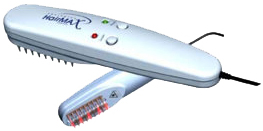27.02.2008
in Uncategorized

INTRODUCTION
Some say it is the hair that makes the man or the woman; it’s been called our crowning glory and defines our style, framing our personal presentation. For many people, losing their hair is a frustrating experience.
Thanks to the HairMax LaserComb®, there is now well founded hope for those suffering from hair loss and thinning hair.
Lexington International, LLC began developmental work on Laser PhotoTherapy over 20 years ago in Australia. Since then, the company has been at the forefront of this emerging technology. In 2001, the HairMax was introduced to the market and, from its inception, over 90% HairMax users are satisfied with their results.
In 2007, the HairMax received clearance by the US FDA for the Promotion of Hair Growth in males with certain classes of Androgenetic Alopecia (male pattern baldness). The HairMax is marketed in 90 countries and is the first and only medical device ever cleared by the FDA for “Promotion of Hair Growth”.
The handheld HairMax is available without a prescription and is a one time cost that delivers long term benefits. It is portable, easy to use, requires only three treatments per week. HairMax is even described as “therapeutic” or “soothing” by many of its users.

How the HairMax Works
The HairMax works via the principle of Photo-BioStimulation, a process by which laser energy is delivered to the hair follicle. While the exact mechanism of action is unknown, it is hypothesized that Laser PhotoTherapy stimulates growth factors within the hair follicle.
Some users report stabilization of hair fallout at the onset of treatment followed by subsequent faster and thicker new hair growth. This points to the fact that the HairMax effectively targets the hair follicle at the cellular level and in some way both speeds up the hair growth process while at the same time inducing the growth of a thicker (or terminal) hair where a thin, dying hair may have been in place previously.
PATIENT CANDIDATES
Your physician will discuss with you whether the HairMax is appropriate for treating your condition.
INDICATIONS FOR USE
The HairMax LaserComb is indicated to promote hair growth in males with androgenetic alopecia who have Norwood Hamilton Classifications of IIa to V and Fitzpatrick Skin Types I to IV.
(Studies on the use of the HairMax LaserComb in women have just been completed.)
STUDIES DEMONSTRATING
HairMax EFFECIVENESS
A clinical trial in support of the FDA submission was designed and conducted as a multicenter, randomized, sham-device controlled trial. It was conducted under strict GCP (Good Clinical Practices) guidelines and was overseen by an IRB (Independent Review Board).
The primary aim of the study was to assess the following:
promotion of hair growth
cessation of hair loss
changes in hair density
scalp overall health
safety
Study subjects used the HairMax three times per week on non-concurrent days for a total of 26 weeks. Hair density measurements were recorded at baseline and at 26 weeks, with additional clinical visits taking place at 8 and 16 weeks.
CLINICAL RESULTS
Subjects in the HairMax treatment group demonstrated a significantly greater increase in hair density (+19.80 cm2) than subjects in the placebo (sham-device) group (-7.60 cm2). Subjects in the HairMax group also had significantly better self assessments of overall hair health and regrowth than subjects in the placebo group.
There were no reports of adverse side effects from any of the subjects.
You can buy the HairMax LaserComb direct from us:
HairMax LaserComb Premier Model £335.00 RRP
HairMax LaserComb Compact SE Model £245.00 RRP
Do you have Hair Loss Problems, read our Hair Loss Help











